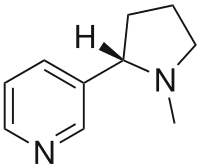
Photo from wikipedia
It has been assumed that the cardioprotective effects of propofol are due to its non-anaesthetic pleiotropic cardiac and vasodilator effects, in which gasotransmitters (NO, H2S and CO) as well as… Click to show full abstract
It has been assumed that the cardioprotective effects of propofol are due to its non-anaesthetic pleiotropic cardiac and vasodilator effects, in which gasotransmitters (NO, H2S and CO) as well as calcium influx could be involved. The study on isolated rat heart was performed using 4 experimental groups (n=7 in each): 1) bolus injection of propofol (100 mg/kg bw, i.p.); 2) L-NAME (NO synthase inhibitor, 60 mg/kg bw, i.p.)+ propofol; 3) DL-PAG (H2S synthase inhibitor, 50 mg/kg bw, i.p.)+ propofol; 4) ZnPPIX (CO synthase inhibitor, 50 μmol/kg bw, i.p.)+ propofol. Before and after the verapamil (3 μmol/L) administration, cardiodynamic parameters were recorded (dp/dt max and min, SLVP, DLVP, HR, CF), coronary and cardiac oxidative stress parameters. The results showed significant increases of DLVP following NO and CO inhibition, but also increases of CF following H2S and CO inhibition. Following verapamil administration, significant decreases of dp/dt max were noted after NO and CO inhibition, then increase of DLVP following CO inhibition, and increase of CF following NO, H2S or CO inhibition. Oxidative stress markers were increased but CAT activity was significantly decreased in cardiac tissue. Gasotransmitters and calcium influx are involved in pleiotropic cardiovascular effects of propofol in Wistar male rats.
Journal Title: Canadian journal of physiology and pharmacology
Year Published: 2019
Link to full text (if available)
Share on Social Media: Sign Up to like & get
recommendations!